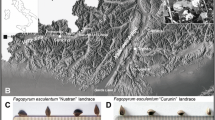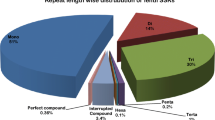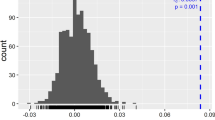Abstract
Traceability of local and typical food products is essential for market protection and consumer trust. DNA analysis is the most dependable tool to identify the biological materials present in a food product. In this work, we molecularly characterized an important local product of the Umbria region, a lentil landrace named after the village Castelluccio di Norcia, in the province of Perugia, Italy, awarded the Protected Geographic Indication (PGI) “Lenticchia di Castelluccio di Norcia” by the European Union in 1997. Four accessions from a 1994 collection were compared with accessions acquired in 2016 at local retailers, in comparison with two commercial samples from grocery stores and two foreign varieties. Twelve simple sequence repeat (SSR) molecular markers allowed to clearly establish the genetic distinctiveness of local lentil. High allelic diversity and very low heterozygosity were observed in Castelluccio samples. The 1994 materials were closely related, as shown by pairwise Fst and by Principal Coordinates Analysis. Little divergence between 1994 and 2016 samples was found, possibly due to 20 years of cultivation in different farms, but one of the 2016 samples was unrelated, as were the two commercial samples. The genetic identity of the Castelluccio landrace is still preserved locally, but may be put at risk by the presence on the market of unrelated materials labeled as PGI. In Castelluccio accessions, as many as 42 private SSR alleles were documented, which can be implemented to develop molecular traceability tests.



Similar content being viewed by others
Data availability
All data generated or analysed during this study are included in this published article and its supplementary information files.
References
Andeden EE, Baloch FS, Cakir E, Toklu F, Ozkan H (2015) Development, characterization and mapping of microsatellite markers for lentil (Lens culinaris Medik.). Plant Breed 134:589–598. https://doi.org/10.1111/pbr.12296
Barcaccia G, Albertini E, Torricelli R, Russi L, Tomassini C, Falcinelli M (1998) Molecular characterisation of local varieties of lentil and emmer. In: Proceedings of IV Convegno Nazionale sulla Biodiversità, 8–11 September 1998, Alghero, Italy
Dent E, VonHoldt BM (2012) STRUCTURE HARVESTER: a website and program for visualizing STRUCTURE output and implementing the Evanno method. Conserv Genet Resour 4:359–361. https://doi.org/10.1007/s12686-011-9548-7
Dikshit HK, Singh A, Singh D, Aski MS, Prakash P, Jain N, Meena S, Kumar S, Sarker A (2015) Genetic diversity in Lens species revealed by EST and genomic simple sequence repeat Analysis. PLoS ONE 10:e0138101. https://doi.org/10.1371/journal.pone.0138101
Evanno G, Regnaut S, Goudet J (2005) Detecting the number of clusters of individuals using the software STRUCTURE: a simulation study. Mol Ecol 14:2611–2620. https://doi.org/10.1111/j.1365-294X.2005.02553.x
FAOSTAT (2016) http://www.fao.org/faostat/en/#home. Accessed Dec 2018
Hamwieh A, Udupa SM, Sarker A, Jung C, Baum M (2009) Development of new microsatellite markers and their application in the analysis of genetic diversity in lentils. Breed Sci 59:77–86. https://doi.org/10.1270/jsbbs.59.77
Hamwieh A, Udupa SM, Choumane W, Sarker A, Dreyer F, Jung C, Baum M (2005) A genetic linkage map of Lens sp. based on microsatellite and AFLP markers and the localization of fusarium vascular wilt resistance. Theor Appl Genet 110:669–677. https://doi.org/10.1007/s00122-004-1892-5
Idrissi O, Udupa SM, Houasli C, De Keyser E, Van Damme P, De Riek J (2015) Genetic diversity analysis of Moroccan lentil (Lens culinaris Medik.) landraces using Simple Sequence Repeat and Amplified Fragment Length Polymorphisms reveals functional adaptation towards agro-environmental origins. Plant Breed 134:322–332. https://doi.org/10.1111/pbr.12261
Jain N, Dikshit HK, Singh D, Singh A (2013) Kumar H (2013) Discovery of EST-derived microsatellite primers in the legume Lens culinaris (Fabaceae). Appl Plant Sci 1(7):1200539. https://doi.org/10.3732/apps.1200539
Kaur S, Cogan NO, Pembleton LW, Shinozuka M, Savin KW, Materne M, Forster JW (2011) Transcriptome sequencing of lentil based on second-generation technology permits large-scale unigene assembly and SSR marker discovery. BMC Genom 12:265. https://doi.org/10.1186/1471-2164-12-265
Ligges U, Machle M (2003) Scatterplot3d—an R Package for visualizing multivariate data. J Stat Softw 8:1–20
Martins-Lopes P, Gomes S, Pereira L, Guedes-Pinto H (2013) Markers for food traceability. Food Technol Biotechnol 51:198–207
Michalakis Y, Excoffier L (1996) A generic estimation of population subdivision using distances between alleles with special reference for microsatellite loci. Genetics 142:1061–1064
Mutou C, Tanaka K, Ishikawa R (2014) DNA extraction from rice endosperm (including a protocol for extraction of DNA from ancient seed samples). In: Henry RJ, Furtado A (eds) Cereal genomics: methods and protocols, methods in molecular biology, vol 1099, p 10
Negri V (2003) Landraces in central Italy: where and why they are conserved and perspectives for their on-farm conservation. Genet Resour Crop Evol 50:871–885
Nei M (1978) Estimation of average heterozygosity and genetic distance from a small number of individuals. Genetics 89:583–590
Peakall R, Smouse PE (2012) GenAlEx 6.5: genetic analysis in Excel. Population genetic software for teaching and research—an update. Bioinformatics 28:2537–2539
Pinheiro J, Bates D (2000) Mixed-effects models in S and S-Plus. Springer, New York
R Development Core Team (2013) R: a language and environment for statistical computing. R Foundation for Statistical Computing, Vienna. http://www.R-project.org. Accessed Dec 2018
Ruisi P, Longo M, Martinelli F, Di Miceli G, Frenda A, Saia S, Carimi F, Giambalvo D, Amato G (2015) Morpho-agronomic and genetic diversity among twelve Sicilian agro-ecotypes of lentil (Lens culinaris). J Anim Plant Sci 25:716–728
Sonnante G, Pignone D (2007) The major Italian landraces of lentil (Lens culinaris Medik.): their molecular diversity and possible origin. Genet Resour Crop Evol 54:1023–1031. https://doi.org/10.1007/s10722-006-9153-x
Tamura K, Peterson D, Peterson N, Stecher G, Nei M, Kumar S (2011) MEGA5: molecular evolutionary genetics analysis using maximum likelihood, evolutionary distance, and maximum parsimony methods. Mol Biol Evol 28:2731–2739. https://doi.org/10.1093/molbev/msr121
Torricelli R, Silveri DD, Ferradini N, Venora G, Veronesi F, Russi L (2012) Characterization of the lentil landrace Santo Stefano di Sessanio from Abruzzo, Italy. Genet Resour Crop Evol 59:261–276. https://doi.org/10.1007/s10722-011-9682-9
Zaccardelli M, Lupo F, Piergiovanni AR, Laghetti G, Sonnante G, Daminati MG, Sparvoli F, Lioi L (2012) Characterization of Italian lentil (Lens culinaris Medik.) germplasm by agronomic traits, biochemical and molecular markers. Genet Resour Crop Evol 59:727–738. https://doi.org/10.1007/s10722-011-9714-5
Zaya DN, Ashley M (2012) Plant genetics for forensic applications. Methods Mol Biol (Clifton, NJ) 862:35–52. https://doi.org/10.1007/978-1-61779-609-8_4
Zohary D (1995) Lentil: Lens culinaris (Leguminoseae - Papilionoideae). In: Smartt J, Simmonds NW (eds) Evolution of crop plants. Longman Scientific & Technical, Harlow, pp 271–274
Funding
This study was funded by Fondazione Cassa di Risparmio di Perugia (2016.0024.021—Ricerca scientifica e tecnologica).
Author information
Authors and Affiliations
Corresponding author
Ethics declarations
Conflict of interest
The authors declare that they have no conflict of interest.
Additional information
Publisher's Note
Springer Nature remains neutral with regard to jurisdictional claims in published maps and institutional affiliations.
Electronic supplementary material
Below is the link to the electronic supplementary material.
Rights and permissions
About this article
Cite this article
Ceccobelli, S., Ciancaleoni, S., Lancioni, H. et al. Genetic distinctiveness of a Protected Geographic Indication lentil landrace from the Umbria region, Italy, over 20 years. Genet Resour Crop Evol 66, 1483–1493 (2019). https://doi.org/10.1007/s10722-019-00799-1
Received:
Accepted:
Published:
Issue Date:
DOI: https://doi.org/10.1007/s10722-019-00799-1




